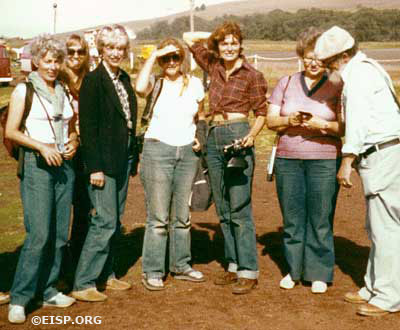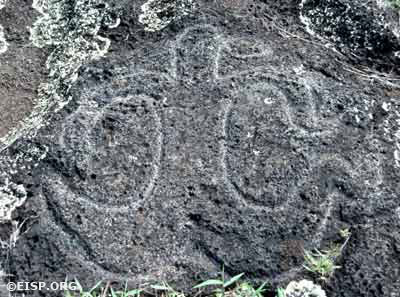Easter Island Statue Project History: 1981

UREP Project Participants, Hanga Roa, Mataveri Airport, (left to right) Joan Seaver, Marcia Opel, Joanne Weinhof, Georgia Lee, Jo Anne Van Tilburg, Esther Schwartz, Ron Hoskinson. Photo by: Johannes Van Tilburg/EISP
In the summer of 1981, Jo Anne Van Tilburg was a member of the University of California Research Expeditions Program (UREP). Led by Georgia Lee and conducted under the auspices of Chile’s Council of Monuments, the goal of the six-week volunteer project was to investigate the nature and extent of the island’s corpus of rock art.
Rock art recording on Easter Island consisted of making photographs and scale drawings at about 25 petroglyph sites and one painted site. Some sites were damaged, and others had been previously recorded in one way or another. At the major tourist sites of Anakena, Tongariki, and Orongo, we made rubbings.
With about 60% of the island surveyed Claudio Cristino F., director of the University of Chile’s Centro de Estudios, estimated that there were about 300 rock art sites. At the end of the 1981 field season he called for the complete recording of them as well as the “stylistic analysis of the colossal heads, or moai.” There was an obvious and logical division of labor between recording rock art and documenting monolithic statues (a necessary first step toward stylistic analysis). Lee returned with the rock art survey in 1982, and in the summer of the same year Jo Anne Van Tilburg initiated the Easter Island Statue Project.

Petroglyph of a ceremonial oject (rei miro), Hanga Piko, Rapa Nui (Easter Island). Photo by: Jo Anne Van Tilburg/EISP
Want to know more?
Lee, G. and J. Van Tilburg 1982. “Rock art on Easter Island.” Archaeology Nov.-Dec., 58-9.
Van Tilburg, J. and G. Lee 1987. “Symbolic stratigraphy: Rock art and the monolithic statues of Easter Island.” World Archaeology 19(2): 133-149.
 English
English  Español
Español